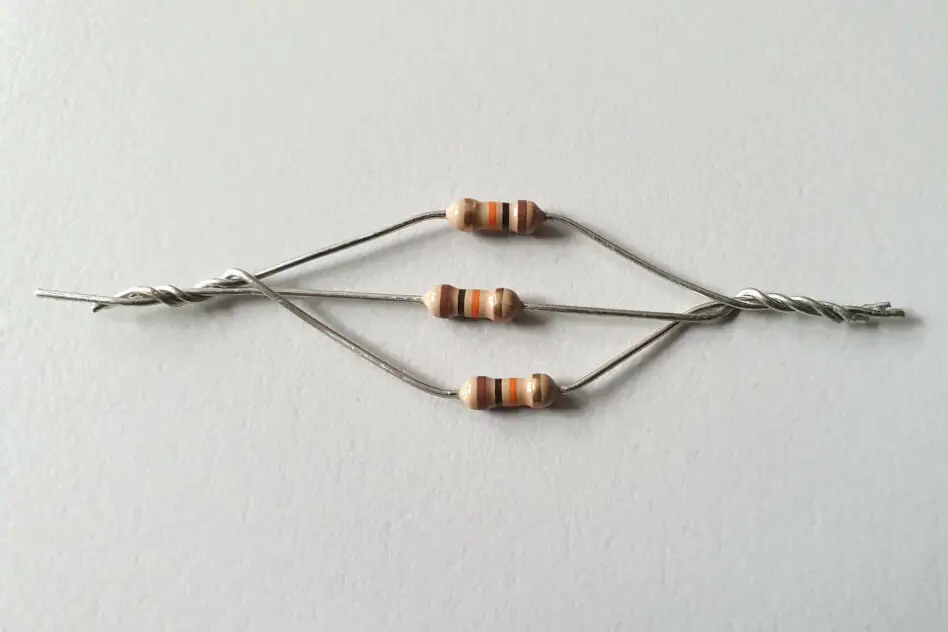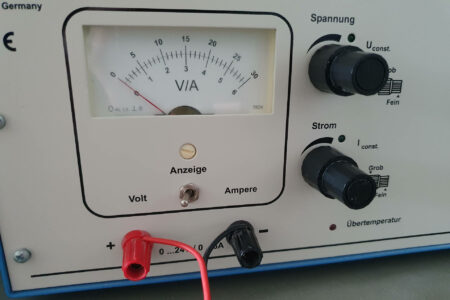When connecting two or more resistors in parallel, the current is divided at the junction point and converged after it. But how large is the total resistance in such a parallel circuit? Here you will find the formula and a simple online calculator for quick calculations.
Total Resistance of a Parallel Connection
In a parallel connection, the current divides at the junction and flows through the resistors $R_{1}$, $R_{2}$ up to $R_{n}$. The same voltage $U$ drops across each of these resistors. The total resistance (also referred to as equivalent resistance) is smaller than the smallest individual resistance in the parallel connection.
Calculating Parallel Connection Resistance
Formula: Resistors in Parallel Connection
To calculate the total resistance of a parallel connection with two resistors, the following formula is used:
$$ R_{total} = \frac{R_{1} \cdot R_{2}}{R_{1} + R_{2}} $$
For a circuit with more than two resistors, the general formula is used:
$$ \frac{1}{R_{total}} = \frac{1}{R_{1}} + \frac{1}{R_{2}} + \cdots + \frac{1}{R_{n}} $$
Parallel Connection Resistance Calculator
The following online calculator helps you calculate the total resistance in a parallel connection with just a few mouse clicks. First, select the number of resistors in the parallel connection, and then enter the individual resistance values.
Manual Calculation
In some situations, such as during an exam, you might not have access to the online calculator. Here are the steps to manually calculate the total resistance without any tools:
- Take Reciprocals: Calculate the reciprocals of the individual resistances in the parallel connection
- Addition: Add the reciprocals of the individual resistances
- Calculate Total Resistance: Take the reciprocal of the sum to obtain the total resistance of the parallel connection
Behavior of Voltage and Current
In a parallel connection, the same voltage is applied across all resistors, which is equal to the total voltage:
$$ U_{total} = U_1 = U_2 = … = U_n $$
However, the current is divided among the different branches:
$$ I_{total} = I_1 + I_2 + … + I_n $$
According to Ohm’s law, in a parallel connection, the smallest resistance results in the highest current flow.
Comparison: Parallel Connection and Series Connection
In this section, we compare the parallel connection with the series connection of resistors in a circuit.
In a series connection, all resistors are arranged in a sequence. The current flows through each resistor in sequence. The total resistance (equivalent resistance) in a series connection is calculated by summing up the individual resistances:
$$ R_{total} = R_1 + R_2 + R_3 + \dots $$
In a parallel connection, the current divides into multiple paths, each with its own resistor. The total resistance (equivalent resistance) of a parallel connection is smaller than the smallest individual resistance. The calculation of the equivalent resistance is done using the reciprocal formula:
$$ \frac{1}{R_{total}} = \frac{1}{R_1} + \frac{1}{R_2} + \frac{1}{R_3} + \dots $$
The main differences involve current strength and voltage:
- In a series connection, the current $I$ is the same throughout the circuit, while the voltage across each resistor can vary.
- In a parallel connection, the voltage $U$ is the same across each resistor, while the current strength in the individual branches of the circuit can vary.
In both configurations, the equivalent resistance can be replaced with equivalent circuits without altering the behavior of the entire circuit.
For the series connection, this means that the equivalent resistance is equal to the sum of the individual resistances, while in the parallel connection, the equivalent resistance corresponds to the reciprocal formula.



